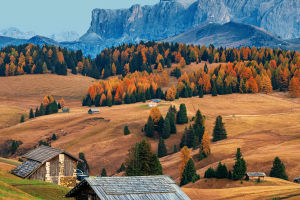Landscape photography is the art of capturing the dynamic and serene aspects of the natural world.
Through the lens of a camera, photographers can immortalize their interpretation of nature's beauty, making landscape photography a remarkable medium of expression.
While photographers occasionally explore more creative approaches and experiment with shallow depth of field, there is a classic technique in landscape photography that emphasizes sharpness throughout the image.
Achieving a large degree of focus is easiest by using a compact camera or adjusting the lens to the smallest aperture. The smaller the aperture, the greater the depth of field, resulting in a sharper overall image.
An essential tool in a landscape photographer's magic box is a tripod or monopod. Since choosing a small aperture often requires a slower shutter speed, additional camera stabilization becomes crucial.
Attempting to capture handheld shots without stabilizing the camera may compromise the technical perfection of the photographs. Moreover, a tripod proves valuable when using a remote control to release the shutter, further enhancing stability and minimizing the risk of camera shake.
Every photograph necessitates a visual centerpiece, and landscape photos are no exception. Failing to identify compelling focal points when capturing natural scenes can lead to mundane and uninteresting shots.
The focal point can be a captivating structure or building, a tree with a unique shape, a striking boulder, or a majestic mountain peak. It is important to remember that focus should not be limited to the focal point alone; the positioning of other significant elements within the composition is equally important.
In general, the ideal time to capture landscape photographs is just after sunrise or within the hour leading up to sunset, commonly referred to as the "golden hour." During this magical period, the changing sunlight transforms the landscape, imbuing it with captivating beauty and a myriad of colors.
However, it is important to note that waiting for the golden hour in mountainous regions may not always yield the expected results. Therefore, when embarking on a mountain hike, it is advisable not to rely solely on the golden hour and risk missing out on other breathtaking opportunities.
Understanding and expressing the unique characteristics of the environment is crucial in landscape photography, as the distinctive qualities of the surroundings directly contribute to the subject's essence.
Residing in Xinjiang, a region teeming with diverse geography and landforms, offers a multitude of choices for capturing breathtaking scenes. From the pale Gobi Desert to the ancient poplar forests spanning billions of years, vast grasslands, majestic snow-capped mountains, crystal-clear lakes, and winding rivers, the options are limitless.
When selecting a scene to photograph, it is essential to establish a theme that aligns with the scenery's characteristics, employing suitable techniques to ensure a harmonious relationship between the people and the landscape.
The composition of a landscape portrait should be dictated by the scene and the desired expression. The image should be concise, with the subject prominently featured. In terms of scenery, the distant landscape takes center stage, with people occupying a smaller portion of the frame, complementing the overall composition.
At this distance, facial expressions may be less prominent, relying instead on body posture and overall form to enhance the image's quality and convey the intended message. Medium shots serve as an organic combination of full-body portraits and the surrounding environment, making them a common choice for landscape portraits.
Close-ups, such as headshots or busts, tend to focus on the portrayal of people, demanding a deep understanding of the scene's characteristics to create a harmonious interplay between the subject and the environment. The key is to position the figure in a manner that complements the sparseness of the landscape, ensuring a sense of coherence and harmony.
Landscape photography allows photographers to capture and convey the beauty and essence of the natural world.


